PinotFile: 6.36 August 13, 2007
|
Oregon Relishes Burgundian InfluenceThe pioneers of Oregon Pinot Noir were emigrants from California. Charles Coury (Charles Coury Winery), David Lett (Eyrie Vineyards), Dick Ponzi (Ponzi Vineyards), and Dick Erath (Knudsen Erath, now Erath Vineyards), headed north to Oregon in the 1960s when the thrust of the California wine industry was Cabernet and very little Pinot Noir was being produced. There were only five premium wineries in Napa Valley at the time. Dick Ponzi had searched in California for suitable growing sites for Pinot Noir, including the Anderson Valley, but found land prices too steep. Bill Blosser, who was to found Sokol Blosser Vinery in 1970, also looked at California first. Napa’s Gary Andurs established Archery Summit in the 1980s, Napa’s Carl Doumani and Steve Girard started Benton Lane, and Napa’s William Hill opened Van Duzer. These prospective winegrowers were not only deterred by unaffordable land prices, but also by California winemaking which emphasized pumps, filters and other technology suitable for many varietals, but undesirable for Pinot Noir. It was only natural that Oregon looked to Burgundy for guidance. By 1981, Oregon had begun its Steamboat Conference (which was not open to consumers or wine writers) with the original intention of sharing information between winemakers from Oregon and California. It was the Burgundians who began attending this event that created the most impression on Oregon winemakers. Robert Drouhin of Domaine Drouhin in Beaune, France, had visited Oregon in the 1970s and in 1987, purchased 180 acres in the Dundee Hills. Named Domaine Drouhin Oregon (DDO), this French-inspired winery really brought vindication and notoriety to the Oregon wine industry and helped to foster a long standing interchange between Oregonians and Burgundians. The Burgundians have since participated with regularity in the Steamboat Conference as well as the International Pinot Noir Celebration which occurs shortly after Steamboat each July. Oregon has had plenty in common with Burgundy. The midpoint of the Willamette Valley lies at 45 degrees north latitude, the same as for Burgundy’s Cote d’Or. Vintages in Oregon tend to parallel those in Burgundy (see Oregon vintage rundown on page 4). Oregon wineries have always been small, family-owned affairs, just like in Burgundy. The Dijon clones of Pinot Noir were first brought into this country by workers at Oregon State University who had a close working relationship with the Burgundians. A number of people think that Oregon is rife with hippies making wine out of garages in their backyards. That may have been largely true back in the late 1960s, but today Oregon Pinot Noir is crafted by a group of talented and dedicated winegrowers. They may sport beards, ponytails, and a laid back attitude, but the Pinot Noir they produce is world-class. Vinifera grapes were first planted in Oregon as far back as 1828 (about the time they were introduced into California). The wine industry’s modern era was ushered in by pioneering winegrower Richard Somner of Hillcrest Vineyard in Roseburg in the Umpqua Valley. He planted Riesling in 1961 and was the first to produce commercial quality wine in Oregon. Somner is largely forgotten, because most winegrowers followed David Lett to the Willamette Valley, 150 miles to the north, presumably because it was much closer to Portland. 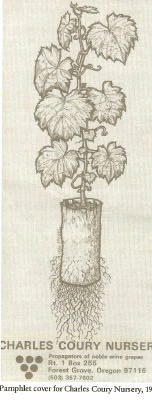 Coury chose Oregon as the best place to prove his hypothesis and in 1965 planted Pinot Noir in his vineyard there. David Lett and Bill Fuller followed Coury to Oregon shortly thereafter. Coury became the second winemaker in post-Prohibition Oregon to produce a decent commercial wine. He operated the Charles Coury Winery, Vineyards and Nursery until 1978. Coury was also one of the first winegrowers in this country to take an interest in Pinot Noir clones. According to John Haeger in North American Pinot Noir, he reputedly brought ‘suitcase clones” to Oregon from Burgundy in the 1960s. The historic Coury property is now the David Hill Winery. Coury was a leader and educator for newcomers. His ideas led to the formulation of Oregon’s labeling regulations, quarantines on plant material, and the establishment of the viticultural research center at Oregon State University. In 1971, he was actively teaching viticulture at Rogue Community College. According to people who knew Coury, his early Pinot Noirs were world class. In the 1980s, Coury left Oregon and returned to California to begin a venture in the microbrewery industry. He passed away on June 23, 2004 from lung cancer at the age of 73. He is remembered as setting the vision for the current Oregon wine industry.  Utah-born, David Lett, had a BA in philosophy before beginning his wine studies at Davis. His professor, Harold Berg, had told him that there were very few climates in the United States cool enough for the successful cultivation of Pinot Noir. Lett was committed to planting Pinot Noir and considered both New Zealand and Portugal. He kept coming back to Oregon, thinking it was the closest climate to Burgundy. Finally, at age 25, he moved to Oregon’s Dundee Hills with 3,000 vine cuttings. In 1965 he planted Pinot Noir and related varietals, despite the warnings of his colleagues that the grapes would never ripen in the cold Oregon climate. Whether Coury or Lett planted the first Pinot Noir in Oregon is up for dispute and it little matters as they both made significant contributions to the fledgling Oregon wine industry. Lett’s first harvest was in 1970, a year after Woodstock, and he sold a few hundred cases of “Oregon Spring Wine” for $2.65 a bottle. Supposedly he sent out four hundred invitations to a release party and received only one response. His beginnings were inauspicious, but the wines improved with every vintage and the Oregon Pinot Noir Era was off and running. In 1979, Robert Drouhin set up a blind tasting of French Burgundies versus American Pinot Noirs. At the Gault-Mileu tasting held in Paris, a 1959 Domaine Drouhin Chambolle-Musigny came in first, but David Lett’s 1975 Eyrie Vineyards South Block Reserve Pinot Noir took second. Lett’s Pinot Noirs have since become well-known for their age ability. Today, he has 50 acres of organically farmed, own-rooted, non-irrigated vines producing 8,000-10,000 cases annually. His son, Jason Lett, handles the main winegrowing chores now. David Lett has been producing a single vineyard Pinot Noir longer than any other winemaker in the United States. In addition, he was the first to produce a New World Pinot Gris in 1970. About the time that Lett’s Pinot Noir astonished the international wine scene, there were 34 bonded Oregon wineries farming 1,100 acres of vineyards.  There were many other early winegrowers of importance: David Adelsheim (Adelsheim Vineyard), Dick Ponzi (Ponzi Winery & Vineyards), Fred Arterberry (Arterberry Winery, now Duck Pond), Jim and Loie Maresh (Dick Erath’s first grower, today they still own Maresh Red Barn B&B and the Maresh Vineyard, planted in 1970), Jim and Donna Jean McDaniel (now Torii Mor Winery), Bill and Bessie Archibald (vineyard now owned by Archery Summit), Dr, John and Sally Bavers, Gary and Saundra Fuqua, Tom and Sharon Saucy, and Dan and Christine Jepson. In 1970, there were 5 wineries and 35 vineyard acres in Oregon. The number of wineries has tripled in the last decade and last year alone 49 new wineries opened their doors. There are now at least 364 wineries producing wine from 72 different varietals. Oregon has the third largest number of wineries in the United States behind California (1,905) and Washington state (430). Pinot Noir is the most widely planted grape by far (nearly 80% of all vineyard plantings), and nearly half of Oregon’s total case sales are Pinot Noir. Wine grape growers harvested 13,381 acres in 2006, and of those about 9,000 were Pinot Noir. Wine grape crops in 2006 posted gross sales of $46.7 million, an increase of 27.6% over 2005. 2006 saw the largest sales rise in seven years, the largest jump in production in the last decade, and the biggest increase in harvested acres in the last 10 years (11,344 acres in 2005, 6,300 acres in 1997). Although Oregon has done well to promote its healthy wine industry, a few curiosities arise. The state beverage is milk despite the fact that wine is now the state’s most visible agricultural product. The state flower is the Oregon grape which is actually a holly bush and not a wine grape plant at all. Rain is synonymous with Oregon, but unfairly so, for in the Willamette Valley, there is no more rain than other cool climate wine growing regions of the world. That is not to say that rain isn’t a problem, for much of Oregon’s rainfall occurs in the spring and fall (as well as through the winter), with dry conditions in mid-summer. Oregon has made many commendable contributions to the modern success of Pinot Noir. The winemakers here were among the first to embrace exclusive use of French oak barrels, new and old. Strict labeling laws in the state require any wine labeled Pinot Noir to be 100% Pinot Noir . The LIVE (Low Input Viticulture and Enology Program) certification program begun in 1997 by Ted Casteel of Bethel Heights, requires designated wineries to use minimal chemical additives, no off-farm chemicals and fertilizers, and strive for maximal biodiversity.
In the earlier years, crop thinning was crucial. 1995 through 1997 were the “rain years.” Since 1999, vintages have been more consistent in part due to improved winegrowing know how. 1982 Decent, soft wines, no longer drinkable. 1983 Big, tannic wines. 1984 A rainy vintage, mostly poor wines. 1985 An excellent vintage with ripe and concentrated wines. 1986 Many are lean and tannic, variable vintage. 1987 Again, variable with some very good wines. 1988 A classic year with balanced wines that were generally excellent. 1989 A hot year, wines were good if not picked too late. 1990 Cold winter and cool spring, low yields, some great wines. 1991 Late, ripe harvest. 1992 Good vintage. A hot year, but heat declined near harvest. Some very good wines. 1993 Fall was warm and dry resulting in long hang times. Some good wines. 1994 More fruit-forward California-styled wines. A hot season. Wines were ripe and flashy. 1995 Rainy vintage, many dilute wines. 1996 Rain at harvest, variable vintage, often tannic wines. 1997 Rain and more rain resulting in high yields, many watery and tannic wines. 1998 Cool weather at bud break led to reduced yields. Classic, concentrated wines lacking acidity. 1999 One of Oregon’s finest vintages. The wines have aged very well due to perfect balance. The best wines came from those who dropped fruit anticipating the rains near harvest. 2000 A very good vintage with noteworthy aromatics in the wines. 2001 Excellent vintage that ranks close to 1999, especially for wineries that restricted yields. 2002 May be Oregon’s finest vintage ever. Wines have perfect balance and classic Pinot flavors. 2003 A record year for heat. Many wines are extracted, high in alcohol, high in tannin, with low acidity. 2004 Another excellent vintage with balanced flavors, acidity and tannins. A challenging vintage with rains in September which left before final ripening. Low yields. 2005 Rain and cool weather in the Spring and at harvest. Challenging vintage with irregular flowering. Harvest went well into November for many wineries. Wines have higher acidity. 2006 Record yields due to higher than normal rainfall in the winter. Dry summer. Large average cluster size. High quality, clean fruit. 2007 So far, so good. Mild summer, veraison only recently.
Shea Vineyard & Shea Wine CellarsDick Shea worked for years on Wall Street in New York City. He decided to move his family out West, and while searching for an appropriate setting, had his wine epiphany: an Adelsheim Oregon Pinot Noir. Oregon soon became his chosen spot, and with two east coast partners, he planted Shea Vineyard in 1989. Concurrently, nearby Beaux Freres Vineyard (Robert Parker and his brother-in-law Mike Etzel share ownership of the property) was being planted. At the time, the Yamhill-Carlton District was largely untested for Pinot Noir. The Willakenzie soils were considered by some to be inferior for viticulture compared to the popular Jory soils found in the nearby Dundee Hills Now the Shea Vineyard is surrounded by several other premier Pinot Noir vineyards including those owned by Willakenzie, Patricia Green, and Penner-Ash. The Yamhill-Carlton District, north of McMinnville, is centered around the small towns of Carlton and Yamhill. There are now more than 1,200 acres of vineyards in this appellation which offers unique growing conditions. The Coast Range of mountains to the west shelters the region and creates a rain shadow over the district. Additional protection is provided by the Chehalem Mountains to the north and the Dundee Hills to the east. The ancient marine sediments in the area are some of the oldest soils in the Willamette Valley and drain quickly creating a natural deficit-irrigation effect. In the early 1990s, Dick bought out his partners and remains the sole owner today. This large vineyard consists of 200 hillside acres, of which 140 acres are planted to Pinot Noir, and 5 acres to Chardonnay. The vineyard faces south at an elevation of 320-625 feet and is divided into two hills, named East and West, separated by a valley containing native plants and trees. The Pinot Noir planting is divided into multiple blocks. Vineyard manager, Javier Marin, has been at Shea Vineyard since it was initially planted. Shea Vineyard has been chosen one of only 32 vineyards out of 500 in the Yamhill River basin by the US Department of Agriculture as having the highest level of stewardship of the land. The original vines of Pommard and Wädenswil clones were planted on their own roots. Inevitably, phylloxera afflicted the vineyard and planned replanting progressed over time, reaching completion in 2005. The newer plantings include Dijon clones 114, 115, 777 and 828. The vineyard has never been irrigated (new plantings are watered the first year). Dick told me he us dug up five-year-old vines and their roots go down 8 feet. 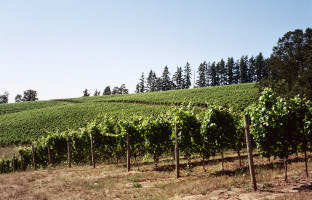 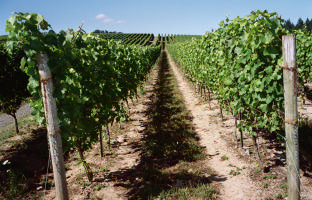
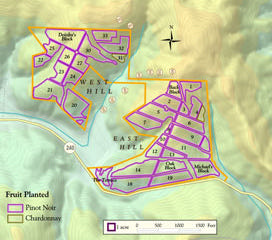 Since 1996, Dick has had his own label, Shea Wine Cellars. Several winemakers were involved during the early years of the program, but since 2004, Chris Mazepink (previously at Willamette Valley Vineyards and Lemelson) has been the full-time winemaker. Experienced tasters have talked about a certain “Shea-ness” that seems to be expressed in the wines from this vineyard. A consistent floral aroma and a dark red fruit character with spice seems unusually clear and unique to this vineyard. The Pinot Noirs are designated as Estate (a blend of several blocks), block or clone designates which vary from year to year, and a special reserve wine labeled “Homer.” Dick Shea is a baseball fan, but bears no relation to Shea Stadium in New York. Dick’s wife and business partner, Deirdre, often compares Dick to Homer Simpson, so the name “Homer” has dual meaning. The Homer cuvee is from the best barrels and is the most voluptuous of the lineup, needing several years to reach its prime drinking window. The Shea Wine Cellar Pinot Noirs have become a cult-classic collectible, eagerly sought by many Shea aficionados on the winery’s mailing list. (Chris, left, and the Sheas, right, pictured below). The 2005 wines, ranging in price from $40 to $75, are sold out. 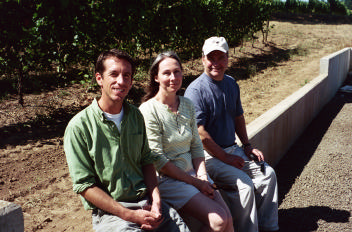 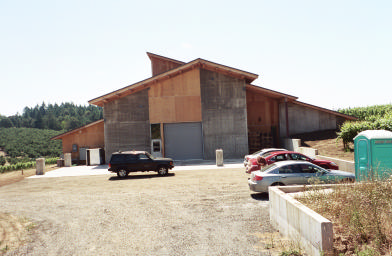
 It is easy to slough off the Shea Chardonnay, but I must warn you, you would be missing a great wine. Dick and Chris take Chardonnay seriously. Sure, up until the last few years, there were not many great Chardonnays from Oregon. But once the proper clones were planted, and once wines were not subjected to excessive oak, great Oregon Chardonnay began to emerge and surprise the wine cognoscenti. Chris makes a very appealing Chardonnay that walks the middle ground between the heavily oaked, full-malo, buttery Chardonnays, and the austere, acidic Chablis-styled ones. He both barrelferments and tank ferments the Chardonnay in separate lots and mixes the two together. The Chardonnay vines are cropped at two tons per acre like the Pinot Noir, resulting in Chardonnay with fine concentration and quality. Plans are to increase production to 600 cases a year. I tasted the 2006 Chardonnay prior to bottling and admired its crispness, pear and citrus notes, and restrained but attractive vanilla oak highlights. Look for a future program on Grape Radio where taped interviews with Dick and Dierdre Shea, Chris Mazepink, and Javier Marin will be presented along with a tasting of the 1995 vintage of Shea Wine Cellars Pinot Noirs. Most of the Shea Wine Cellars wines are sold through a mailing list at www.sheawinecellars.com. Production numbers are about 3,000 cases of the Estate and 900 cases of the other Pinot Noirs. 80% of the fruit from Shea Vineyard is sold to other wineries. The Corvallis, Oregon fine wine retailer, www.avalonwine.com, is also a good source for Shea wines. These are benchmark Pinot Noirs for the Yamhill-Carlton AVA, and worthy of any pinoaficionado’s cellar. The words “Shea Vineyard” on any Oregon Pinot Noir is pretty much a guarantee of a Pinot Noir with plenty of charisma.
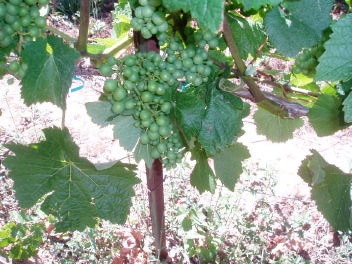
Et FilleHoward Mozeico started making wine in his garage in 1984. He became quite accomplished, garnering seven Gold Medals for his Pinot Noir in seven state home winemaking competitions. He was encouraged by friends and relatives to become a full-time winemaker and when his daughter, Jessica, agreed to assist him with the 2000 vintage, he began his commercial winemaking career. The name Et Fille (“a few”) was chosen, which in French means “and daughter.” Howard jokes that “Mozeico Et Fille” just wouldn’t work. His wines have been well reviewed and soon he plans on leaving the software company he co-founded to devote himself entirely to Et Fille. 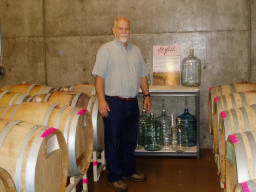 Howard’s goal is to craft small lots of distinctive singlevineyard Pinot Noirs that reflect the unique character of each individual vineyard. No two of his wines are made exactly in the same fashion, and each wine is an expression of a specific Oregon terroir. He sources grapes from several prime vineyards including the well-known Maresh Vineyard. The wines are vinified at August Cellars, a state-of-the-art gravity flow winery just off Highway 99W in Newberg. August Cellars was founded by Tom Schaad and is fashioned after the Carlton Winemaker’s Studio, which hosts ten wineries under one roof. At August Cellars, eight separately bonded wineries share space and equipment. Each winery has its own dedicated space for storing barrels during the blending and aging process. The facility opened in 2004 and has a tasting room that is open weekdays during the summer and weekends all year. 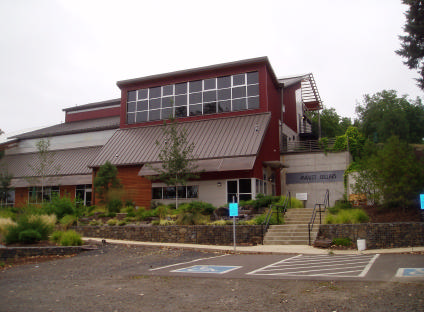 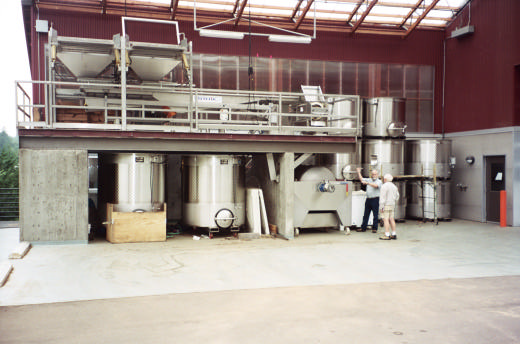
2006 Et Fille Deux Vert Vineyard Yamhill-Carlton Viognier 150 cases, $26. Deux Vert is one of the few Oregon Viognier vineyards. The wine is off-dry (0.5% residual sugar). · This is a fine example with complex tropical aromatics, a viscous mouth feel, hints of banana and citrus and a clean finish.
2005 Et Fille Kalita Vineyard Yamhill-Carlton Willamette Valley Pinot Noir 13.5% alc., 91 cases, $32. This 10 acre vineyard was planted in 1999 to Pommard and Dijon clones 113,114,115 and 777. The wine was aged for 10 months in 75% new French oak. · The perfume is exotic with spiced cherries, mahogany, and cigar box most evident. The flavors are woodsy and earthy, with prominent mushroom notes as well as red licorice highlights. At this stage, the aromas trump the flavors, but this filly (sic) hasn’t gotten out of the gate yet.
2005 Et Fille Elton Vineyard Eola-Amity Hills Pinot Noir 126 cases, $36. Elton Vineyard is a mature vineyard planted in the 1980s and farmed by Dick and Betty O’Brien. Pommard clone. Aged for 10 months in 50% new oak. I tasted this at the winery as well as at home a couple of weeks prior. · There is plenty of structure here but the wine is not jammy. The nose opens up with wild strawberries and buttered toast. The complex flavors include dark cherries, red currents, wild berries, white pepper and tobacco. The finish is clean and satisfying with tangy acidity. Cellaring will enhance this wine further.
2005 Et Fille Maresh Vineyard Dundee Hills Pinot Noir 13.5% alc., 125 cases, $38. Maresh Vineyard has produced striking Pinot Noirs by Rex Hill Vineyards and others for over thirty years. Howard is able to source Pommard clones from two blocks at Maresh. One block, the “Reservoir,” is the only part of the vineyard still farmed by Jim Maresh, who originally planted the vineyard. Aged 10 months in 100% new French oak. · The fruity and woodsy nose offers great interest. Plenty of dark cherries at its heart, this beauty offers additional notes of baking spice, vanilla and shrooms. The long, long finish is striking. Very nice balance here.
2003 Et Fille Seven Springs Vineyard Eola-Amity Hills Pinot Noir Howard just discovered a few more cases of this wine and is offering it at $42. · This is stunning with a flamboyant nose of crushed and spiced red berries that carries through to the finish. The tannins are velvety and the finish lingering. I could still taste this wine in my memory a few hours later.
As you can tell from the wines offered, Howard prefers the Pommard clone as he believes it makes a more complete wine. I also tasted several 2006 barrel samples and the Kalita Vineyard Yamhill- Carlton and Maresh Vineyard Dundee Hills really stood out. Production is small, about 1,500 cases, and most of the wine is sold through a mailing list. The 2005 lineup of Pinot Noirs are sold out, but you may find a bottle at www.avalonwine.com. The website is www.etfillewines.com and the phone number is 503-449-5030. Tasting can be arranged by appointment.
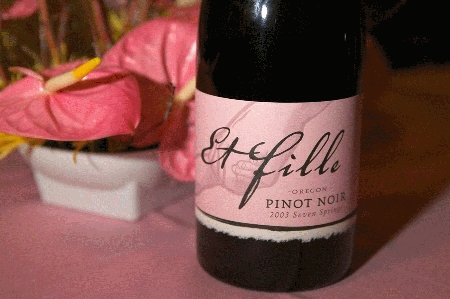
Scott Paul WinesProprietor/winemaker Scott Paul Wright had a thirty-year career in marketing and promotion for the radio and record industries He became the Managing Director of Domaine Drouhin, where he worked for several years before starting his own winery in Carlton, Scott Paul Wines. The tasting room is housed in a restored circa-1915 creamery (photo left), and the winery building across the street has been completely and tastefully retrofitted inside a former grainary. (photo right). 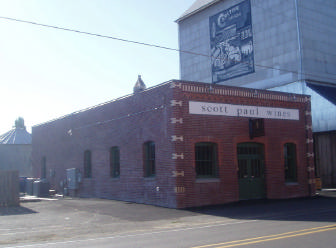 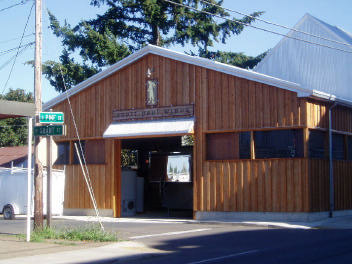 Last year, Scott Paul Wines started a new Burgundy import division under the name, Scott Paul Selections. Three of the producers from the portfolio attended this year’s International Pinot Noir Celebration: Romain Taupenot of Domaine Taupenot-Merme, Aleth Girardin of Domaine Aleth Girardin, and Thierry Violot of Domaine Thierry Violot-Guillemard. The timing for Scott is fortuitous, because the 2005 vintage of Burgundy is as Allen Meadows says, “The best top-to-bottom vintage of young Burgundy I have ever tasted, period, full-stop!” Scott has had a life-long passion for Burgundy. His tasting room is quite unique and the only one I know of in the United States that gives the visitor the opportunity to taste both New World and Old World Pinot Noir side by side. Scott’s wines are crafted in the Burgundian tradition with low-yields in the vineyard, hands off vinification in the winery with no pumps, no inoculation, no enzymes, no additives, no fining and no filtering (what exactly does Kelley and Scott do all day?), and small amounts of new French oak (20% at most). He follows the dictum that “Pinot Noir makes itself,” and his wines are a pure expression of Pinot Noir. Each vintage, there are three cuvées sourced from several of Oregon’s finest vineyards including Maresh, Momtazi, Shea, Ribbon Ridge and Stoller. Production is about 3,000 cases a year. Scott does not craft single vineyard Pinot Noirs (there is always an exception, see Audrey below) because “If we had vineyards that were reliably and demonstrably different and special in the New World, I fully believe the wines from those vineyards should be bottled and labeled separately. However, I think that we’re too early in the game to be making those calls yet. It’s rare to have a vineyard with vines over 30-years-old around here. Future generations will surely know which plots are indeed our Grand Cru vineyards, but we’ve truly only just begun.”
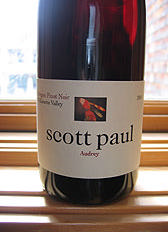 2005 Scott Paul Cuvée Martha Pirrie Willamette Valley Pinot Noir 13.5% alc., 469 cases, $24, screw cap. From Shea, Stoller and Ribbon Ridge Vineyards. Named after Daughter Martha Pirrie Wright. · This Pinot reminds me of a ballet dancer - light on its feet with plenty of grace. Lovely nose of cherries, sandalwood and spice. Flavors of ripe cherries, vanilla, herbs and leather lead to a clean finish buttressed by lively acidity. A little oak peeks out on the nose but is totally immersed in the flavors. You would be happy, happy with this one which is not at all tiring to drink. Boo, hoo, sold out (you may still find it in retail stores).
2005 Scott Paul Le Paulée Willamette Valley Pinot Noir 13.5% alc., 945 cases, $40, screw cap. 40 barrels are selected from three vineyards for this blend. · Terrific potpourri of bright cherry, spice, cola and oak among the aromas. The flavors follow in step with the aromatics. Very sexy satin texture. Still a little shy on the palate, this wine needs a little cellaring to fully blossom.
2005 Scott Paul Audrey Willamette Valley Pinot Noir 13.5% alc., 130 cases, $55. This represents a selection of a few favorite barrels of the vintage. Audrey is named after the cinematic icon Ms. Hepburn who personified grace and elegance. This is a unique wine in that all of the fruit came from Maresh Vineyard. This vineyard was planted in 1970 (making it the fourth oldest planting in Oregon), and is Wädenswil clone on own-rooted, non-irrigated vines. · I tasted this wine briefly at the IPNC Salmon Bake so I don’t have extensive notes. I remember that I was bowled over by the powerful and intoxicating aromatics. I found plenty to like as I sampled the wine and this is definitely the most striking, complex and age worthy Pinot Noir in the Scott Paul lineup.
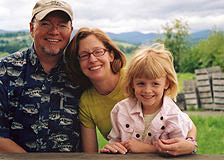
Anam Cara CellarsI had the opportunity to meet and work with Sheila Nicholas at this year’s IPNC. Nick and Sheila Nicholas have a 30-acre vineyard planted in 2000 and 2001 located on the southeast slopes of the Chehalem Mountains, just north of the town of Newberg. Lying between 450 and 650 feet in elevation, the welldrained soils are primarily Jory series. Five blocks of Pinot Noir are planted to Pommard, 114, 115, 667 and 777 clones. Originally the property was an overgrown walnut, plum and hazelnut orchard with a neglected Christmas tree forest and included a quaint farmhouse dating from 1902 and several wooden outhouses. Farming is sustainable with emphasis on organic and biodynamic practices. The words Anam Cara are Celtic for “friend of my soul” and symbolize the journey the Nicholas’s have taken to make their wine and the relationship they have with the vineyard. The label depicts the vineyard and the entwined vines logo (not pictured) symbolizes the owners relationship with their land, and with each new friend who shares their wine. 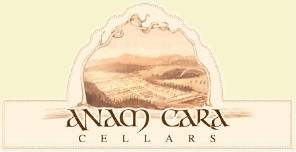
2005 Anam Cara Cellars Nicholas Estate Chehalem Mountains Willamette Valley Pinot Noir 13.7% alc., 678 cases, $30. This is a blend of all five blocks of the estate vineyard. · I tasted the wine briefly at an alfresco luncheon at IPNC and this made the hairs stand up on the back of my neck. It was soft and elegant, but packed with charming red and black Pinot fruits. Most striking was the peacock tail finish which I rarely encounter.
2005 Anam Cara Cellars Nicholas Estate Reserve Chehalem Mountains Pinot Noir 13.7% alc., 213 cases, $42. This was the wine chosen by IPNC to be poured at the event. It represents fruit from specific rows which are cropped to insure low tonnage and maximal flavor concentration. · This Pinot Noir has more power and structure than the bottling above and will need a few years in the cellar to flesh out. That said, it is completely fine now, with charming notes of black fruits, earth, cocoa, and spice.
2005 Anam Cara Cellars Heather’s Vineyard Chehalem Mountains Willamette Valley Pinot Noir 13.7% alc., 75 cases, $60. This wine came from three barrels originating from a single block of Dijon clone 114 vines that were remarkable for their softness and complexity. The decision was to bottle them separately as blending in with the Estate and Reserve would overwhelm the charm. A special wine for sure, it takes its inspiration from daughter heather Nicholas, and as Sheila notes, “is continuously evolving, deeply expressive, and full of surprises.” Not tasted.
Anam Cara wines can be purchased by phone, 503-537-9150 or by e-mail inquiry at info@anamcaracellars.com. Limited Edition Wine Club members receive twice yearly mailings of six bottles of limited production Anam Cara Cellars estate wines including Pinot Noir, Riesling, and Gewürztraminer. The website is www.anamcaracellars.com.
Capitello WinesRay Walsh, a native New Zealander who grew up in Auckland, got the bug to make wine after a trip to Europe at age twenty. He obtained his enology degree in New Zealand and worked at a number os wineries including Limeburner Bay, Villa Maria, Waitakere, and Cooper’s Creek. He made the move to the United States in 1993, signing on as cellar master with the newly built King Estate Winery located just southwest of Eugene, Oregon. By 1999, he had become the head winemaker and eventually was shouldered with additional executive duties and the task of producing 50,000 cases of wine each year. He longed to return to his more personal winemaking roots and left King Estate in 2005 to found his own label, Capitello. Capitello is taken from the dialect word capitiello, meaning nipple. He likes to say he learned winemaking in New Zealand and winegrowing in Oregon. Ray rents space from Territorial Vineyards and Wine Company in Eugene and sources fruit from Hauer of the Dauen Vineyard and from three vineyards farmed by Matt Compton of Spindrift Wines. He was one of the first Oregon winemakers to utilize a reverse osmosis system to reduce alcohol in his wines when needed.
 2005 Capitello Willamette Valley Pinot Noir 13.5% alc., $35. · Deep violet in color. Oak-tinged cherry pie nose with luscious dark cherry flavors. Clean and sleek, it cascades over the tongue like Mobil 1. A deft touch of oak flows throughout. I could chug this one.
Capitello Wines are available at www.avalonwine.com. There is also a Pinot Gris of great interest (King Estate has always produced one of the best examples in Oregon) and a dessert wine from Gewürztraminer labeled Dolcino,
Anne Amie VineyardsProprietor Dr. Robert Pamplin, Jr. is a man of many talents. He has earned degrees in business, economics, accounting, education and theology. He is President and CEO of the R.B. Pamplin Corporation and is the founder of the Portland Tribune newspaper, Columbia Empire Farms, Your Northwest retail stores and Anne Amie Vineyards. After purchasing the former Chateau Benoit Winery in Carlton, Pamplin gathered an impressive staff to pursue the goal of producing world-class wines. President Craig Camp came on board in 2004. He has more than 25 years of experience in fine wine marketing, importing and distribution, and has had a long-standing love affair with Pinot Noir. He also is an accomplished wine journalist, serving as wine forum host for www.egullet.org, the internet’s largest wine and food forum, and the author of the popular blog Wine Camp located at www.winecamp.squarespace.com. Winemaker Thomas Houseman became intrigued with fermenting wines from fruits and root vegetables at a young age. Later he brewed beer in his New York City apartment. After pursuing a career in modern dance, he enrolled in the enology program at California State University Fresno. His love for Pinot Noir led him to winemaking at Husch Vineyards in the Anderson Valley of California, and later to New Zealand where he worked at both the Blenheim Winery and at Bell Hill in North Canterbury owned by the Giesen brothers. Upon returning to the states, he perfected his winemaking skills under the tutoring of Dick and Luisa Ponzi at Ponzi Vineyards in Oregon. Like most winemakers, he professes to be a minimalist in the winery (if Pinot makes itself and the winemaker’s job is to do as little as possible, what do they earn the big bucks for? - just kidding of course). At Anne Amie, the Pinot Noir grapes are de-stemmed and 80% of the berries reach the open-top fermentors intact. The wines are moved by gravity-flow and aged in about 25% new French oak. No fining or filtration is used. In wine publications, talk rarely turns to the viticulturists but their role has become very important in the production of Pinot Noir. Director of Viticulture at Anne Amie, Jason Tosch, is an Oregon native who came to Anne Amie from Ponzi Vineyards. He has transforming all of the estate vineyards at Anne Amie to LIVE (Low Input Viticulture & Enology - www.liveinc.org) and Salmon Safe. He notes, “Encouraging the vines using balanced and sustainable practices in the vineyards creates the stage for what Pinot Noir in Oregon soils is meant to do: perform beautifully.” I had the opportunity to taste through three Pinot Noirs from the Anne Amie portfolio. There are three levels: an entry-level Pinot Noir - Cuvée A, a Winemaker’s Selection Pinot Noir, and The Vineyard Designates.
2005 Anne Amie Vineyards Cuvée A Pinot Noir 13.5% alc., $20, screw cap. The more fruit-forward barrels of wine are selected to make a reasonably priced wine for everyday drinking. · A very light wine with subtle oak and fruit highlights, especially raspberry. A good summer quaffer served cold. Add pomegranate juice and berries for a cool wine slushy.
2004 Anne Amie Willamette Valley Winemaker’s Selection Pinot Noir 14.4% alc., $35. This is a blend of the finest barrels from the complete range of Willamette Valley vineyards. · A subdued nose of red fruits, tea and oak leads to simple and pleasant red fruit flavors. An appealing softness on the palate supplies elegance.
2004 Anne Amie La Colina Vineyard Dundee Hills Pinot Noir 14.5% alc., $50. a “Cru” selection that reflects a particular terroir. Less than 200 cases. Proprietors Dee and George Hillberry farm the La Colina Vineyard located due east of the winery. This is always the richest and most velvety Pinot Noir in the Anne Amie portfolio. · More plush stuffing here. Deep aromas of black cherries and blackberries carry over in the flavors to follow. Very soft and silky in texture. The wine picks up a little oomph with air time and still tasted quite good the next day from the previously opened bottle.
Annie Amie Vineyards is located at 6580 NE Mineral Springs Road in Carlton. The beautiful tasting room (below) is open daily. Wines may be ordered from the website at www.anneamie.com. 503-864-2991. The winery produces Pinot Gris, Pinot Blanc, and Riesling as well. 
Cardwell Hill CellarsIt’s a small world. Close neighbors of mine, Dan and Nancy Chapel own a vineyard and winery in Philomath, Benton County, in the Willamette Valley just west of the town of Corvallis. Dan was a very successful engineer at Fluor Corportion and found winegrowing to be a challenging outlet for his creative juices after he retired. He purchased an overgrown vineyard in a picturesque location in Southern Oregon and transformed the property into a magnificent wine estate featuring a stately home with barrel storage underneath (Dan likes to say that he and Nancy “literally sleep on our wine.”), a modern 7,600 square-foot gravity-flow winery (photo, below right), and a tasting room fronting the winery.    
2006 Cardwell Hill Cellars Estate Reserve Willamette Valley Pinot Noir Barrel Sample A blend of the best 21 barrels, 40% new oak. · Less fruit driven than the Estate with more of everything - structure, earthiness, tea flavors and tannins. Great potential here, but not even close to maturity.
 2006 Cardwell Hill Cellars Estate Willamette Valley Pinot Noir The aromatics are dominated by sweet and candied cherry fruit. There is a hint of alcohol. Very drinkable now, but showing fruit and not much else at this stage.
2005 Cardwell Hill Cellars Estate Willamette Valley Pinot Noir 13.2% alc., 2475 cases, $20. · A more expressive nose with more blue-dark fruits evident. A nice fullness in the mouth with a velveteen texture and a lengthy finish.
2005 Cardwell Hill Cellars Estate Reserve Willamette Valley Pinot 13.2% alc., 375 cases, $28. A selection of the 15 best barrels in the cellar. · Very dark purple in color. A nicely spiced cherry nose with cola, cinnamon, and toast. Over time, spiced apple notes are evident. Full-bodied, but yet showing restraint and a very suave texture. Blue and black fruits dominate with a hint of oak. The tannins are evident but finegrained. This was recently bottled and needs a little time for the flavors to come together completely.
2004 Cardwell Hill Cellars Estate Willamette Valley Pinot Noir 13.2% alc., $20. · A shy nose with soft and demure cherry and berry flavors and a tiny hint of spice. Very light in body.
Cardwell Hill Cellars tasting room is open from early May through Thanksgiving weekend Tuesday through Sunday, from 12-6. The Chapels split their time between Southern California and Oregon, so call ahead to see if they are at the winery (541-929-WINE). Tasting and tours are available year-round by appointment. There are picnic tables on the property with spectacular views of Mary’s Peak and the coastal range of mountains. The wines are sold on the website, www.cardwellhillwine.com, and through retail channels. The prices are quite sensible.
Premier Pacific VineyardsPremier Pacific Vineyards creates and farms high-end vineyards. They acquire investment capital, secure the best sites, and develop world-class vineyards. As the vineyards begin producing and proving their worth, wineries searching for new high-quality vineyards can lease or purchase from the portfolio of vineyard estates in the best winegrowing regions of California, Oregon and Washington. One of the challenges created by the current strong demand for Pinot Noir is ensuring there is an adequate supply of truly high-end vineyards. It is impossible to produce more great Pinot Noir without more quality vineyards. The supply of truly high caliber vineyards is limited by the scarcity of land with the right combination of soil and climatic conditions, regulatory restrictions and limited capital. For example, prime vineyard land in Oregon now costs $50,000 an acre or more, and it costs $20,000 to $25,000 an acre to properly plant and develop a vineyard. Premier Pacific Vineyards was founded by vineyard development pioneer William Hill and real estate developer Richard Wollack. Together, they have rounded up a team of financial, viticultural and wine industry experts and are developing thousands of acres of vineyards throughout California and the Northwest. The company’s investment partners are private investors and the CalPERS retirement fund in California. Prominent Pinot Noir vineyards in California include Cotati Hills and Gap’s Crown in the Sonoma Coast, Bellflower (Piner) in the Russian River Valley, Lone Tree Ridge and Annahala (Philoville) in Anderson Valley, and Rancho Salsipuedes, Santa Rita Ridge and Santa Colina in the Sta. Rita Hills. Oregon properties include Willakia, Roserock Eagle Crest, Roserock Gibson Ridge, Roserock Popcorn Hill and Zena Crown in the Eola-Amita Hills and Gran Moraine, Yamhela and Goodrich in the Yamhill-Carlton District. As reported in the latest issue of Oregon Wine Press (August, 2007), the explosive growth in sales of Oregon Pinot Noir is leading to a shortage of fruit, because the new planting growth rate is declining from historic levels. It is estimated that by 2012, there will be a shortage of almost 15,000 acres in Oregon. Similarly, new plantings in high-end California regions cannot keep up with the growing demands for premium Pinot Noir and other varietals. Premier Pacific now has more than 1,000 acres in Yamhill and Polk counties of Oregon. 778 acres are either being planted or are in the first three years of growth. Clients in Oregon who are already on board include Adelsheim, Antica Terra, Beaux Freres, Belle Vallee, Bergstrom, Bethel Heights, Bighorn, Dobbes Family Winery, Elk Cove, Folio, Francis Tannahill & Hatcher Winery, Grochau, King Estate, Penner Ash , Ponzi, Rex Hill, Scott Paul, Solena Cellars, Soter Vineyards and Torii Mor. In California, the clients include Belle Glos, Brewer-Clifton, David Bruce, Flowers, Francis Ford Coppola, Freestone (Joseph Phelps), Harrington, Kosta Browne, Landmark, Papapietro-Perry and Patz & Hall. As the wineries become familiar with the new vineyards and a compatible working relationship develops, Premier Pacific will allow the wineries to manage their own vineyard blocks (often 10-15 acres) on a long term, usually 12 year, lease arrangement. Before the IPNC, I visited one of the Premier Pacific vineyards, Willakia, in the Amity Hills with Patrick Matheny, the Director of Vineyard Marketing for Premier Pacific. The vineyard is being planted in stages and as we stood at the top of the vineyard (photo below) we could see spectacular vistas which included part of the 120-acre vineyard below. 95 acres are planted to Pinot Noir and the rest to Chardonnay at elevations from 200 to 900 feet. The ground we were standing on had just been ripped in preparation for planting. Patrick told me Premier Pacific was founded in 1998, but really got started in 2000 and has enjoyed remarkable growth since then. Premier Pacific has no intention of getting into the winemaking business. 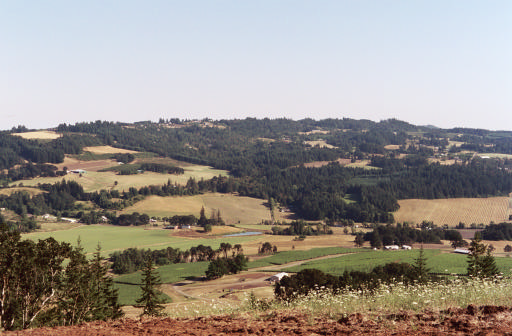
Carlton Enjoys a RevitalizationCarlton, population about 1,500, is a town of .87 square miles located in Yamhill County in the middle of wine country. It is 36 miles south of Portland, and 6 miles north of McMinnville. When I visited Scott Paul Winery before the IPNC, Martha Wright told me about the changes going on in this small, but charming piece of Americana in Oregon. Because Carlton was located a few miles off of Highway 99W, the main thoroughfare through the Willamette Valley, it was historically spared residential and commercial development and is only now undergoing a slow, but promising revival. One of the spearheads of the town renaissance is winemaker Ken Wright, who invested in Carlton some years ago and still makes wine there. Jay McDonald, who owns The Tasting Room in Carlton and produces Pinot Noir under the EIEIO label, has also been instrumental in the progress here. He opened his business in a former bank on Main Street in 1995. 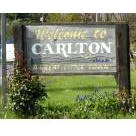 Carlton has become a perfect place for visitors to the Willamette Valley to stay and explore the adjacent Oregon wine country. The town retains its old-time charm, with many businesses now housed in historical buildings that have been preserved. Other than McMinnville and Newburg, there really is no other centrally located town with lodging, restaurants and services that appeal to wine enthusiasts visiting the Willamette Valley. Carlton was always a small farming town with a focus on the dairy and grain industries. Remnants remain such the towering grain silo next to the Scott Paul Tasting Room proclaiming “Where Farm, Industry and Town Unite for Pleasant Living.” 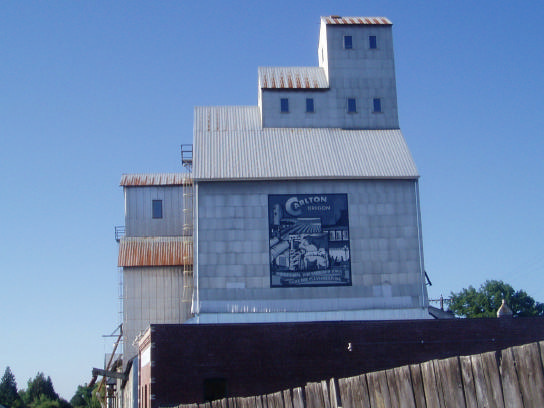 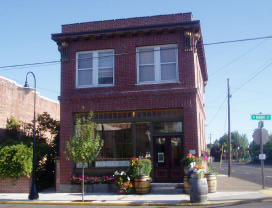 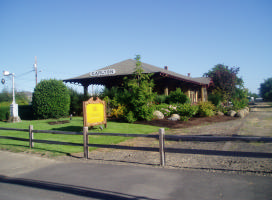

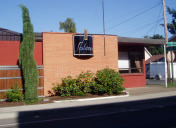
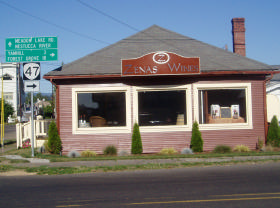 
 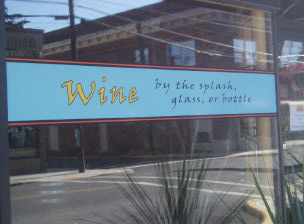
 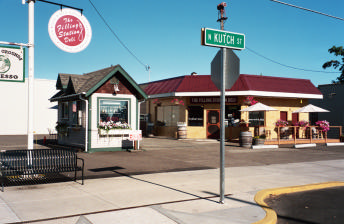 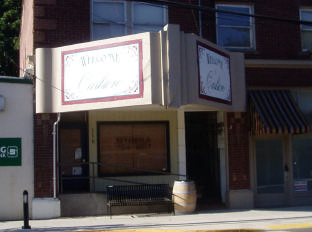 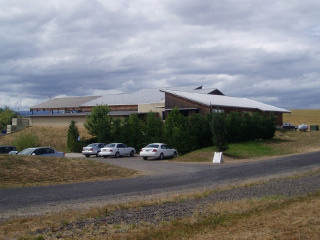 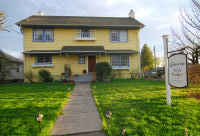 Just outside of town are three other B&B options - Abbey Road Farm, Brookside Inn on Abbey Road, and Lobenhaus. I am told that Abbey Road Farm is REALLY nice. A working farm on 82 acres tucked into rolling hillsides dotted with vineyards, the silo suites are decorated in contemporary country furnishings with king beds and Jacuzzi tubs ($175-$195). The hosts are John and Judi Stuart and their dog Fuzz. Brookside Inn has 9 suites with private baths divided into a Main House and a Carriage House. New owners Bruce and Susan Bandstra took over this 22-acre property in May and have been busy redecorating the rooms ($185-$325). I have stayed at the Lobenhaus B&B and Vineyard and it is quite comfortable with contemporary country decor, a neighboring vineyard, and friendly hosts, Joe and Shari Lobenstein It is situated on 27 acres and there is plenty of room to wander. 6 guest rooms with private baths ($145-$165). In nearby Yamhill, there is the Hideaway Hill B&B and Yamhill Vineyards B&B.  Carlton’s annual Walk in the Park was held recently at Wennerberg Park on August 4-5. This event benefits local charities and features a weekend of artists, musicians, wineries, and local restaurants celebrating Carlton’s lifestyle This year 23 wineries participated and a beer garden was plenty busy. Carlton Wineries, Restaurants, Lodging Wineries (TR = Tasting Room, BA = By Appointment) Anne Amie 6580 NE Mineral Springs Rd, 503-864-2991, www.anneamie.com. TR. Belle Pente 12470 NE Rowland Rd, 503-852-9580, www.bellepente.com. BA. Carlton Cellars PO Box 974, 503-474-8986, www.carltoncellars.com. BA. Carlton Winemaker’s Studio 801 N Scott St, 503-852-6100, www.winemakersstudio.com. TR. Carlo & Julian 1000 E Main St, 503-852-7432. BA. Cuneo Cellars/Cana’s Feast 750 Lincoln St @ Highway 47, 503-852-0002, www.cuneocellars.com. TR Domaine Coteau 258 Kutch St, 503-697-7319, www.domainecoteau.com. TR. Ken Wright Cellars 236 N. Kutch St, 503-852-7070, www.kenwrightcellars.com. Laurel Ridge Winery 13301 NE Kuehne Road, 503-852-7050. TR. Lemelson Vineyards 12020 NE Stag Hollow Road, 503-852-6619, www.lemelsonvineyards.com. BA. Scott Paul Wines 128 S Pine St, 503-274-4700, www.scottpaul.com. TR. Soléna Cellars Tasting room 213 Pine Street, 503-852-0082, www.solenacellars.com. TR. Tyrus Evan 120 N Pine St (at The Depot), 503-852-7070, www.northwestwine.com. TR. Note: Nearly every Oregon winery is open to the Public Thanksgiving and Memorial Day weekends. On other days, call ahead for tasting room hours. Restaurants & Tasting Bars Cielo Blue Main St., Closed Monday, B L & D. Cuvée 214 W Main St, 866-421-1347, Wednesday-Sunday, www.cuveedining.com. Horse Radish Cheese & Wine Bar 211 W Main St., 503-852-6656, www.thehorseradish.com. The Carlton Depot 120 N Pine St, 503-852-7010, Thurs-Mon 11-5, Tyrus Evan, Soléna wines and more. The Filling Station Deli 305 W, Main St, 503-832-6687, Open daily May-Nov, Tues-Sun Dec-April 11-6 www.fillingstationdeli.com. The Tasting Room in Carlton Corner of Main and Pine, 503-8526733, Thurs-Mon 11-5 or by appt. Lodging
Abbey Road Farm B&B 10501 NE Abbey Road, 503-852-6278, www.abbeyroadfarm.com. Brookside Inn on Abbey Road B&B 8243 NE Abbey Road, 503-852-4433, www.brooksideinn.com. The Carlton Inn B&B 648 W Main St, 503-852-7506, www.thecarltoninn.com. Lobenhaus B&B & Vineyard 6975 NE Abbey Road, 503-864-9173, www.lobenhaus.com. R.R. Thompson House B&B 517 N Kutch St, 503-852-6236, www.rrthompsonhouse.com.
“Dumb Phase” - Much Ado About Nothing?A reader sent me a note posted on a wine blog. The blog posting, titled “The Dreaded Dumb Phase,” stated that “Common wisdom holds that good Pinot Noir should be consumed either while young, or left alone to mature in the cellar for at least five years.” The explanation was that after youth, Pinot Noir goes through an adolescent phase in which the fruit goes away and the wine is awkward, the so-called “dumb phase.” This was a perplexing statement to me that made little sense although I am well familiar with wines passing through a dumb phase. Pinot Noir often goes into a muted phase after it is bottled. This may last 6 months or more and is one of the reasons producers hold back wines for 6-12 months before release. The more gentle the process of bottling, the quicker the recovery time. A second muted phase may following shipping which typically lasts 3-4 weeks. It has been my experience that most American Pinot Noirs are not made to age and do not go through any appreciable dumb phase. To wait five years for an American Pinot Noir to mature is to miss the best drinking window for most wines. I asked the opinions of two experienced winemakers. Don Baumhefner (Ridgeway Vineyard) said that “a bottle of Pinot Noir may go through some doldrums for various periods of time. Since each bottle of wine is alive and different, there are no hard and fast dumb phase periods you can predict. I have experienced Joseph Swan Pinot Noirs that went through dumb periods lasting up to ten years, then returning to be even better than they were before they became dumb.” Ted Lemon (Littorai) said that “as for Burgundy, beyond bottle shock, it depends a lot on the estate, vintage, and bottling conditions. Some vintages go through periods when they do not express themselves very well and sometimes it is a precursor to decline, but sometimes they come out of it and return to glory. As a general rule, the more substantial the variety/wine, the more possible it is that the wine can go through a late dumb phase. It is more likely with a great and concentrated vintage of La Tache, even more likely with great Cabernet and more likely still with wines like Port. Pinot Noir, as you well know, is the articulate and beautiful young woman in a silk chemise. “Dumb” is rarely a descriptor which I find appropriate.”
Oregon Invaded By Wine AliensOregon must feel under attack as prime vineyard property continues to be acquired by California companies. I reported in Issue 31 that The Evening Lands (TEL) based in California acquired a long-term lease for the Seven Springs and Anden Vineyards and may purchase the vineyards eventually. Vintage Wine Trust Inc., a real estate investment trust focused solely only on the wine and vineyard industry, recently acquired the 45-acre Farmer Road Vineyard in the Willamette Valley for $1.27 million. The vineyard is leased to A to Z Wineworks (owned by Bill Hatcher and Sam Tannahill), the largest wine producer in Oregon. Vintage Wine Trust Inc. acquires vineyard properties and then leases them to sellers or third parties. Currently, they own two winery facilities with vineyards and control 5,329 net vine acres, located primarily in California. They plan to further expand their vineyard holdings in Oregon in the future. The scramble for prime vineyard land (see article on Premier Pacific in this issue), particularly locations ideal for Pinot Noir, will continue to intensify in Oregon as well as California. |